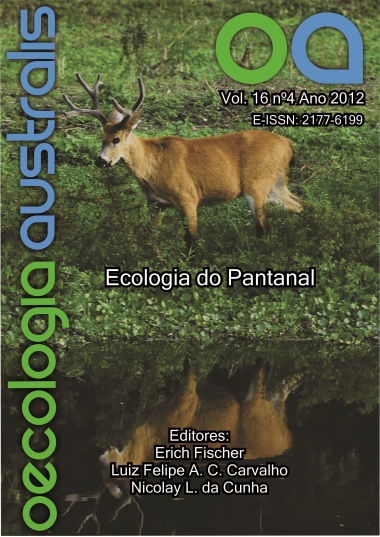STRUCTURE OF TWO COMMUNITIES DOMINATED BY COPERNICIA ALBA AND ASSOCIATIONS WITH SOIL AND INUNDATION IN PANTANAL WETLAND, BRAZIL
Palavras-chave:
monodominance, carandazal, CCA, herbaceous component, tree/shrub component.Resumo
Known for its high degree of biodiversity, the tropics have a number of sites in which one or few species dominate large areas, as occurs in the Pantanal wetland, Brazil, with the ‘carandá' palm, Copernicia alba, in monodominant formations known regionally as ‘carandazal'. The aim of the present study was to analyze variations in species richness and diversity of herbs, shrubs and trees in two communities dominated by Copernicia albawith different flood patterns and determine whether soil fertility and time of inundation are associated with tree/shrub species composition and abundance. Vegetation was analyzed in 50 plots measuring 100m2 in each area, with the determination of the tree/shrub component (CBH ? 5cm). Three subplots measuring 1m2 were demarcated within each plot for the sampling of herbs, sub-shrubs, shrubs (CBH < 5cm) and juvenile arboreal species. Soil samples were taken from three depths in each 100m2 plot. Associations between soil data, time of inundation and absolute density of tree/shrub vegetation were tested using canonical correspondence analysis (CCA). For the tree/shrub component, a total of 22 species belonging to 12 families were sampled in the two communities. Richness was greater in the area submitted to a lesser time of inundation. Copernicia albahad the greatest importance values in both study areas, followed by Tabebuia aureain one community and Mimosa glutinosain the other. In the subplots, 178 species belonging to 39 families were sampled, for which Fabaceae, Poaceae, Asteraceae and Cyperaceae figured prominently. The herbaceous component predominated over the others in species richness in both areas, but similarity was low.CCA detected associations between soil fertility, time of inundation and composition of tree/shrub species. The richness of the tree/shrub component was greater in the area with a shorter inundation time, which makes this event an important factor in the determination of C. albamonodominance in the Pantanal wetland. The herbaceous component demonstrated a high degree of richness and diversity in both communities, although there are differences in the inundation pattern between the two areas.


